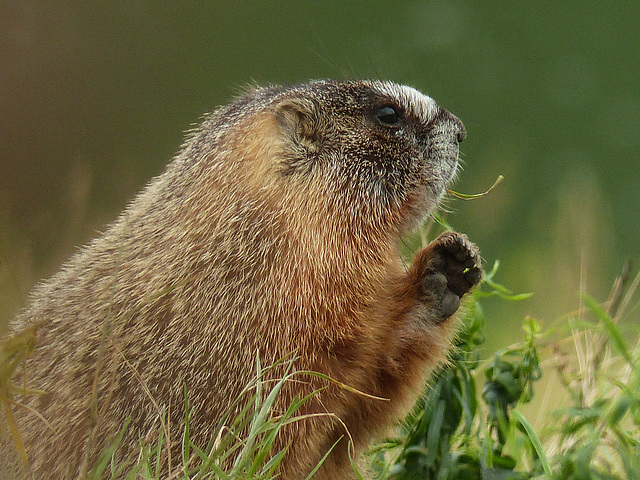See also...
Keywords
Authorizations, license
-
Visible by: Everyone -
All rights reserved
-
186 visits
Yellow-bellied Marmot


The Yellow-bellied Marmot is classified as Secure in the current General Status of Alberta Wild Species report. Even so, I had never seen one, so this was a real treat to see several of these beautiful animals on the final day of a three-day trip down south. Friends, Cathy and Terry, and I, spent two days (26 and 27 August) in beautiful Waterton Lakes National Park, and on the third day (28 August), we drove eastwards for maybe a couple of hours, hoping to see these animals. Most of them were running backwards and forwards in the long grasses, so were not easy to photograph. Another couple of them were high up on the rocky hillside, and lower down was an adult with a young one, who was so cute : )
"Yellow-bellied marmots usually weigh from 1.6 to 5.2 kilograms (3.5 to 11.5 lb) when fully grown, though males typically weigh more than females. Adult males typically weigh between 3 to 5 kilograms (6.6 to 11.0 lb); females typically weigh between 1.6 to 4 kilograms (3.5 to 8.8 lb). They get fatter in the autumn just before hibernating.
Their territory is about 4 to 7 acres (2 to 3 ha) around a number of summer burrows. Marmots choose to dig burrows under rocks because predators are less likely to see their burrow. Predators include wolves, foxes, coyotes, dogs and eagles.
Yellow-bellied marmots spend about 80% of their life in their burrow, 60% of which is spent hibernating. They often spend mid-day and night in a burrow as well. These burrows are usually constructed on a slope, such as a hill, mountain, or cliff. The hibernation burrows can be up to 5 to 7 metres (16 to 23 ft) deep, but the burrows constructed for daily use are usually only 1 metre (3.3 ft) deep. Their hibernation period varies on elevation, but it is typically from September to May.
Yellow-bellied marmots are diurnal. The marmot is also an omnivore, eating grass, grains, leaves, flowers, legumes, fruit, grasshoppers, and bird eggs." From Wikipedia.
en.wikipedia.org/wiki/Yellow-bellied_marmot
During our three days away, we saw so many things, including breathtaking scenery, 4 Black Bears (including one that was swimming in the lake), Bison, Deer (including several that we saw in the town of Waterton (where we stayed for two nights at the clean and friendly Bear Mountain Motel), Golden-mantled Ground Squirrels, Chipmunks, various bird species including a family of Dusky Grouse that are uncommon to the park, a few wildflowers, and a few different insect species. I was so happy to see these Marmots when we drove way east of the park and a bit later in the day, all three of us were so thrilled to find our very first two (possibly three) endangered Burrowing Owls. I even got the chance to see three or four new-to-me old, wooden grain elevators. Oh, and we got caught in a storm like nothing we'd ever seen before - a mesocyclone, apparently.
"Yellow-bellied marmots usually weigh from 1.6 to 5.2 kilograms (3.5 to 11.5 lb) when fully grown, though males typically weigh more than females. Adult males typically weigh between 3 to 5 kilograms (6.6 to 11.0 lb); females typically weigh between 1.6 to 4 kilograms (3.5 to 8.8 lb). They get fatter in the autumn just before hibernating.
Their territory is about 4 to 7 acres (2 to 3 ha) around a number of summer burrows. Marmots choose to dig burrows under rocks because predators are less likely to see their burrow. Predators include wolves, foxes, coyotes, dogs and eagles.
Yellow-bellied marmots spend about 80% of their life in their burrow, 60% of which is spent hibernating. They often spend mid-day and night in a burrow as well. These burrows are usually constructed on a slope, such as a hill, mountain, or cliff. The hibernation burrows can be up to 5 to 7 metres (16 to 23 ft) deep, but the burrows constructed for daily use are usually only 1 metre (3.3 ft) deep. Their hibernation period varies on elevation, but it is typically from September to May.
Yellow-bellied marmots are diurnal. The marmot is also an omnivore, eating grass, grains, leaves, flowers, legumes, fruit, grasshoppers, and bird eggs." From Wikipedia.
en.wikipedia.org/wiki/Yellow-bellied_marmot
During our three days away, we saw so many things, including breathtaking scenery, 4 Black Bears (including one that was swimming in the lake), Bison, Deer (including several that we saw in the town of Waterton (where we stayed for two nights at the clean and friendly Bear Mountain Motel), Golden-mantled Ground Squirrels, Chipmunks, various bird species including a family of Dusky Grouse that are uncommon to the park, a few wildflowers, and a few different insect species. I was so happy to see these Marmots when we drove way east of the park and a bit later in the day, all three of us were so thrilled to find our very first two (possibly three) endangered Burrowing Owls. I even got the chance to see three or four new-to-me old, wooden grain elevators. Oh, and we got caught in a storm like nothing we'd ever seen before - a mesocyclone, apparently.
(deleted account) has particularly liked this photo
- Keyboard shortcuts:
Jump to top
RSS feed- Latest comments - Subscribe to the comment feeds of this photo
- ipernity © 2007-2024
- Help & Contact
|
Club news
|
About ipernity
|
History |
ipernity Club & Prices |
Guide of good conduct
Donate | Group guidelines | Privacy policy | Terms of use | Statutes | In memoria -
Facebook
Twitter

Sign-in to write a comment.